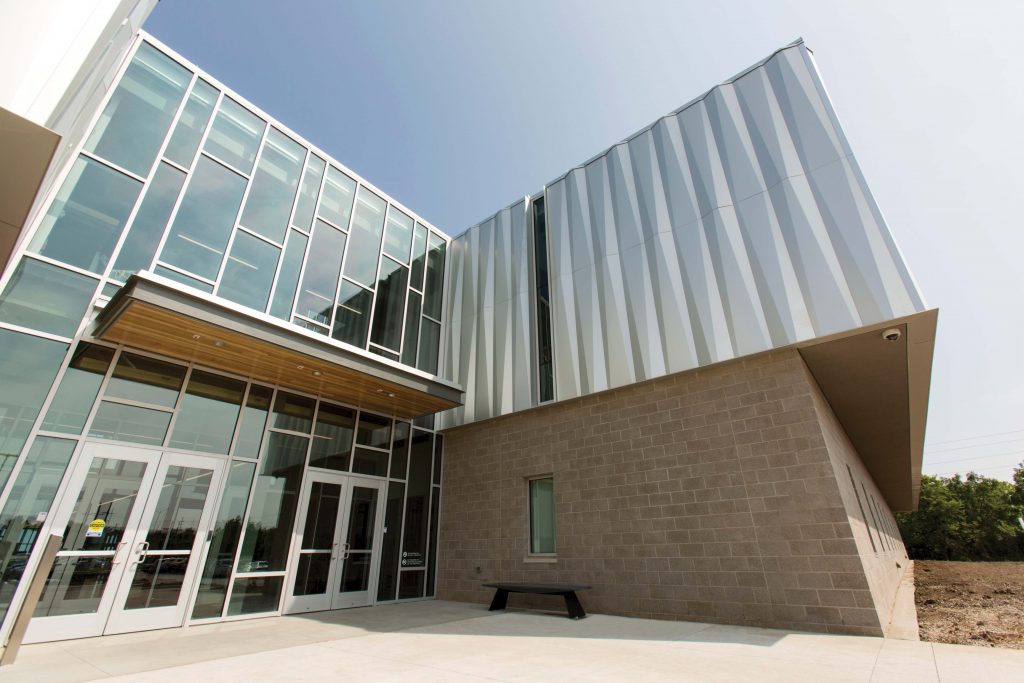Charles Ambrose knows that the Missouri Innovation Campus makes a difference in students’ lives.
Ambrose is the president of the University of Central Missouri in Warrensburg, a key partner in the innovative education program. He’s watched the MIC transform the futures of many young people, such as the Lee’s Summit student who finished his degree at UCM in less than two years, thanks in great part to the time he spent as a high-schooler receiving dual credits for his school work.
Oh, and the student also graduated as an employee of DST, thanks to the paid internship part of the MIC program.
Now, Ambrose is overseeing the biggest change to the program thus far: moving it to its own facility in Lee’s Summit. The two-story, 137,000-square-foot building at 1101 N.W. Innovation Parkway is set to open this month for student use, and is made possible through an innovative partnership between the Lee’s Summit R-7 School District and UCM.
The new building will give the program, which began in 2012, a permanent home and allow students to access its programs-—and those of Summit Technology Academy, which shares the building—from 8 a.m. to 10 p.m.
Solving Higher Ed’s Biggest Problems
The goal of MIC, which focuses on STEM subjects, is for students to graduate from high school already having completed an associate’s degree at Metropolitan Community College, with the opportunity to earn a bachelor’s degree in just two years after high school. Students accumulate little to no student debt, but do walk away with highly sought-after skills for today’s work environment and applied experience gained through paid internships.
Corporate titans such as Hallmark, DST, Cerner, VML, Burns & McDonnell, and Black & Veatch have been early adopters and supporters.
“The goal is to take the silos out of the way and make it easier for students to get a degree,” Ambrose said. The MIC is trying to combat four big problems with higher education as it’s currently delivered right now.
- College costs too much.
- It takes too long.
- Students leave with the skills they need to be workforce-ready.
- Students rack up huge student debt.
Turning the Production Floor into a Classroom
The MIC is designed to help educators and students face the changes and challenges in today’s education and business environments, Ambrose said.
The program grew out of a conversation Ambrose had with Don Nissanka, the chairman, president and CEO of energy storage company Exergonix, about Nissanka’s desire to give back and encourage students and faculty to work with the business community.
“He wanted our students to be his employees, and for the faculty to be his managers and the production floor to be the classroom,” Ambrose said. “It was a simple equation that led to the genesis of this.”
With the new building opening, Ambrose is proud to reflect on the unique partnership of the MIC and the results thus far.
“In our first two graduating classes, all of the students are now fully employed, averaging salaries at $60,000 at the best companies,” he said.
“The reality is that college costs have been the reason that a lot of people have questioned the value of a college degree. But a college degree is the key to social and economic success.”
Ambrose is looking forward to expanding MIC’s program to include adult learning opportunities. He wants to help other universities, school districts and business communities to start up their own programs. And he’d like to welcome more students to MIC.
MIC is also developing a program with the Kansas City (Missouri) Public Schools at the district’s Manual Career and Technical Center.
Everyone connected with the MIC feels as though they are changing education and is ready to take the program to other places.
“Tom McDonnell (former CEO of both DST and the Ewing Marion Kauffman Foundation) tells me, ‘Don’t say it is a new model; it is the new model.’
“The Missouri Innovation Campus was meant to be transformational, and it has been.”

